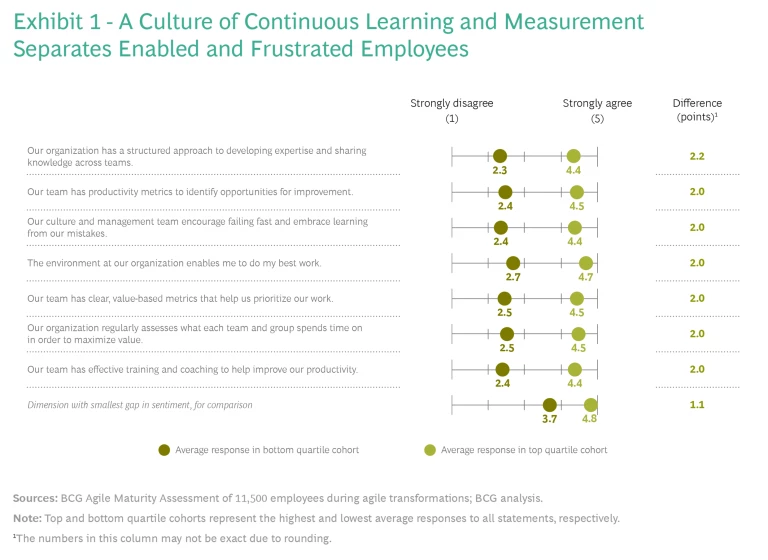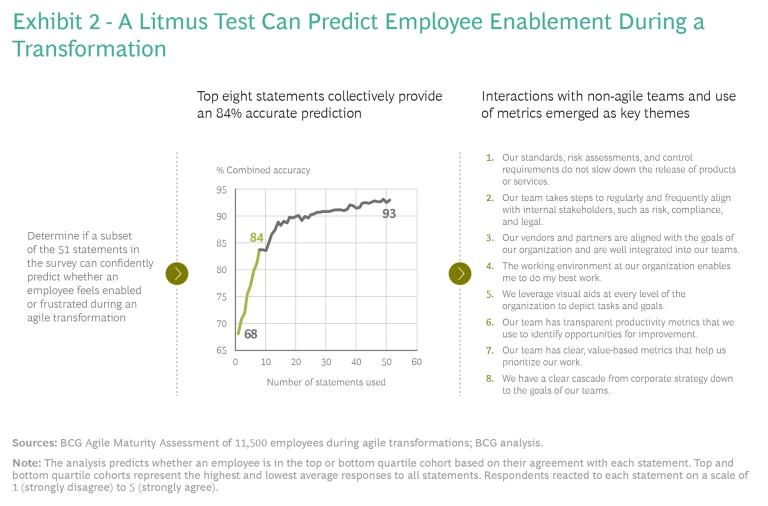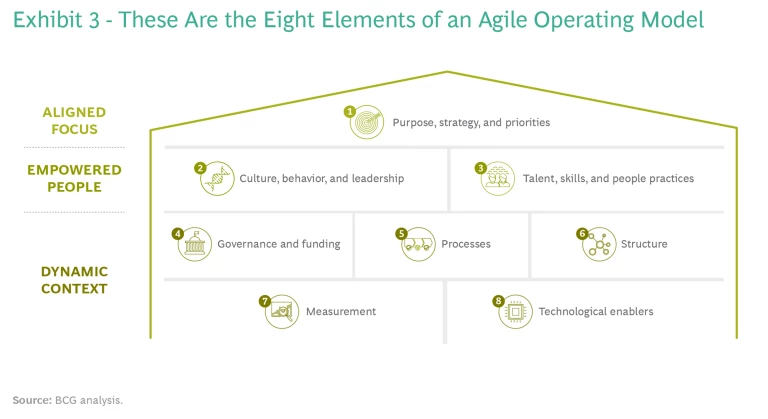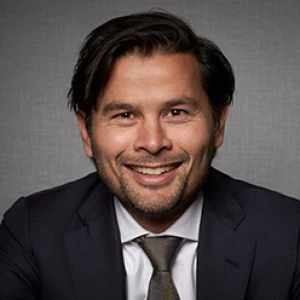Survey questions reveal three key findings that can help transform companies into truly agile workplaces.
At most companies, agile is still a work in progress. Teams at some organizations have achieved breakthrough results. Others are agile in name only, adopting the lingo but not changing the underlying organizational dynamics.
To assess the state of agile as it enters adulthood (the Agile Manifesto turns 21 in February), we went to the source, interviewing those who have participated in agile transformations. About 70% of transformations fail, so we wanted to know whether employees felt supported or stymied in the process. Over the past four years we have surveyed more than 11,500 employees involved in agile transformations at more than 40 companies across 15 industries. (See “About the Survey.”)
About the Survey
The survey consisted of 51 questions that tested whether employees were enabled or hindered during the agile transformation. We averaged each respondent’s answers to identify the top and bottom quartiles. The top quartile had the most positive sentiment and consequently reflected where workers felt more enabled and empowered to embrace agile. The bottom quartile had a more negative sentiment and consequently represented where employees felt more hindered and unlikely to embrace agile.
Three conclusions stand out. First, successful agile organizations are learning organizations. They do not rest on past accomplishments and practices. Nearly nine of ten respondents who feel enabled by their organization’s agile transformation said that their culture and management encourage failing fast and embrace learning from mistakes.
Second, agile teams want data to help them prioritize their work and measure success. Data helps them learn. Unfortunately, too few teams have the data they want. Only half of respondents, for example, said their teams could measure customer satisfaction, a key indicator of team effectiveness.
At its core, agile requires responding to change more than following a plan.
Third, agile runs into trouble when it rubs against the conservative practices and behaviors of traditional organizations. Agile becomes the square peg struggling to squeeze into a round hole. More than half of respondents, for example, said that their organization’s standards, risk processes, and control requirements slow their work.
At its core, agile requires responding to change more than following a plan. Teams are continually testing and refining what they create based on feedback from customers and end users. It’s no wonder that agile team members value learning and smooth interactions with the rest of the organization and want to take advantage of the insights data can provide. (For a summary of what the survey revealed, see “A Quick Take.”)
A Quick Take
- Successful agile organizations are learning organizations; 93% of employees who said they felt enabled in the transformation confirmed that their organization has a structured approach to both developing expertise and sharing knowledge across teams. Only 12% of those who said they didn’t feel enabled agreed that their company had that approach.
- Teams are frustrated by their interactions with legacy corporate structures. More than half of respondents said that standards, risk, and controls slow them down.
- To learn, teams need to measure what they achieve, but many companies lack that ability. Only 53% of respondents said that they can measure customer satisfaction.
- Leaders of successful transformations take these messages to heart. They listen to their employees, remove impediments, reward learning, and invest in ways to measure outcomes.
Agile Organizations Are Learning Organizations
The survey asked respondents to agree or disagree with 51 different statements about agile transformation. We conducted two types of analysis on the survey results. The first focused on uncovering the questions with the largest spread between employees who felt enabled and those who felt frustrated. (To explore the seven statements with the largest gulf between enabled and frustrated employees, see Exhibit 1.)
Enabled employees said that they work at a learning organization. For example, 93% of enabled employees believe that their organization has a structured approach to both developing expertise and sharing knowledge among teams. Only 12% of hindered employees believe this. At least five of the seven statements depicted in Exhibit 1 relate to learning, knowledge sharing, continual improvement, and training. The other four are:
- Our team has productivity metrics to identify opportunities for improvement.
- Our culture and management team encourage failing fast and embrace learning from mistakes.
- The environment at our organization enables me to do my best work.
- Our team has effective training and coaching to help improve our productivity.
Agile is a fundamentally different way of setting priorities, organizing work, making decisions, and learning.
These findings reveal employees who are thirsting for knowledge and expertise. Agile is a fundamentally different way of setting priorities, organizing work, making decisions, and learning. No wonder its deepest roots can be found in learning organizations.
Data and Learning Are Complementary
Agile organizations are also data rich organizations. That is the other key insight from this analysis of large gaps between enabled and frustrated employees. Three of the seven statements displayed in Exhibit 1 have a strong connection to data and metrics:
- Our team has productivity metrics to identify opportunities for improvement.
- Our team has clear, value-based metrics that help us prioritize our work.
- Our organization regularly assesses what each team and group spend time on in order to maximize value.
When employees have near real-time access to data and metrics, they can gauge their performance, productivity, and priorities. Data also strengthens learning organizations by letting employees know what is working and what is not.
Agile Can Clash with Legacy Ways of Working
Our second piece of analysis is a sort of canary in the coalmine. We set out to determine if a small subset of the 51 statements could confidently predict whether an employee felt enabled or frustrated during the transformation. We ordered the statements by individual predictive accuracy, determined how many of the top individual statements to keep in the subset, and interpreted what the eight questions in the subset told us. (See “Why These Eight Statements Matter.”)
Why These Eight Statements Matter
A key theme immediately emerged: the statements did not cover the day-to-day work of agile teams but rather how well agile teams interacted with the larger organization and the receptivity of the rest of the organization to agile practices. Here are the top four statements:
- Our standards, risk assessments, and control requirements do not slow down the release of products or services.
- Our team takes steps to regularly and frequently align with internal stakeholders, such as risk, compliance, and legal.
- Our vendors and partners are aligned with the goals of the organization and are well integrated into our teams.
- The environment at our organization enables me to do my best work.
The first three statements deal with the quality of interactions between agile teams and other departments within the organization and outside vendors. The fourth addresses the overall receptivity of the organization to agile. (To explore other statements with strong predictive power, see Exhibit 2.)
These results are not a substitute for companies doing their own work on employee sentiment and engagement during an agile transformation. But if senior executives want to get a quick read on whether an agile transformation is working, understanding how agile teams interact with the rest of the organization is a good place to start.
This insight is cautionary. Agile will never reach its potential if it is confined to individual teams. Agile teams need to work effectively with parts of the organization that are not agile. But the survey suggests that as agile spreads throughout an organization, it is losing ground to entrenched bureaucracy: in-house lawyers who take too long to review a contract, IT staff who take too long to approve a new digital service, accountants uncomfortable with the more flexible funding requirements of agile teams, vendors unwilling to accommodate agile clients, and so on.
These are all fixable issues. But they cannot be attacked piecemeal. They stem from a root cause: the organization’s operating model was built from a different era and different way of working. Most companies still operate around the pillar of strong functional and vertical departments, while the ideal agile organization is horizontal and cross-functional. Governance, career paths, culture, behavior, and other factors need to be reoriented around cross-functional teams rather than vertical departments. (See Exhibit 3.)
Listen to the Voice of the People
Organizational change is hard. Most large change efforts do not meet their objectives. If you lose the support and engagement of your people, you will almost certainly fall short. Our survey suggests a winning approach: be a learning and data-driven organization, and anticipate that you will need to adjust the operating model to match agile ways of working. None of that is easy—but it is all achievable.
The authors wish to thank Akriti Bhat and Madhav Kattungal for their data analytics expertise that made this article possible.















